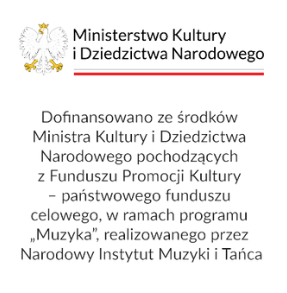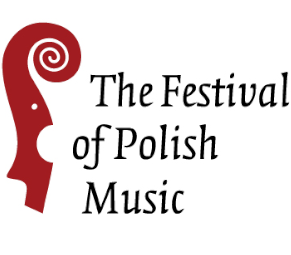at 7 p.m.
FESTUM IUVENTUTIS – FESTIVAL OF YOUTH
Georgi Vasilev
Programme:
Fryderyk Chopin: 2 Polonaises op. 40
- A-dur Allegro con brio
- c-moll Allegro maestoso
3 Mazurki op. 50
- G-dur Vivace
- As-dur Allegretto
- cis-moll Moderato
Nokturn As-dur, op. 32 nr 2 Lento
Barcarolle Fis-dur op. 60 Allegretto
***
Leopold Godowsky: Studium 18a na lewą rękę według Etiudy op. 10 nr 9 F. Chopina
Karol Kurpiński: Polonaise nr. 1 G-dur z cyklu 3 Polonaises
Karol Mikuli: Mazurka h-moll, op. 11
Alexandre Tansman: III Sonatine
- Pastorale. Animé
- Hymne. Lento
- Rondo (perpetuum mobile). Presto
Kazimierz Serocki: Suite of preludes
- Animato
- Affettuoso
- Agitato
- Teneramente
- Veloce
- Capriccioso
- Furioso
Georgi Vasilev, fortepian

Georgi Vasilev
The Bulgarian pianist. Winner of the 3rd International Polish Music Competition in Rzeszow in the Pianist category, Vasilev also received a special prize for his performance of Milosz Magin’s Piano Concerto No. 2, funded by the composer’s daughter, Margot Magin. Georgi Vasilev was also a semifinalist and winner of the prize for the best performance of a work by I. J. Paderewski at the 12th I. J. Paderewski International Piano Competition in Bydgoszcz, and he also won an honorary medal at the 67th Maria Canals International Competition in Barcelona. He has performed many times in Bulgaria, Poland, Italy, Spain and Germany on the stages of famous concert halls such as: National Philharmonic in Warsaw, Lodz Philharmonic, Pomeranian Philharmonic, “Bulgaria” hall in Sofia, Petit Palau de La Musical Catalana in Barcelona, National Palace of Culture in Sofia.
He was born in 2000 in Bulgaria. He graduated from the Lyubomir Pipkov National Music School in Sofia in the piano class of Darina Kantardeva. From 2017 to 2019, he honed his skills with Prof. Ludmil Angelov at the New Bulgarian University. In 2022, he graduated with honors from the Feliks Nowowiejski Academy of Music in Bydgoszcz with a bachelor’s degree under Prof. Katarzyna Popowa-Zydroń. He is currently continuing his education at the master’s level in the piano class of Dr. Paweł Wakarecy. He participated in numerous piano courses conducted by such masters as Dmitry Bashkirov, Kevin Kenner, Ewa Poblocka, Janusz Olejniczak, Piotr Paleczny, Naum Grubert, Giuseppe Guarrera, Alexis Golovin. As part of the 19th edition of the International Piano Forum “Bieszczady without borders”, Vasilev was awarded the “Golden Parnassus” prize.
He was several times the recipient of scholarships from the Ministry of Culture of Bulgaria, the Communitas Foundation and the St. Cyril and Methodius Foundation (Lydia Kuteva scholarship, funded by Prof. Pavlina Dokovska), the Yordan Kamzhalov Foundation. He was also awarded the Scholarship of the Rector of the Feliks Nowowiejski Academy of Music in Bydgoszcz four times.
Chopin wrote the two Polonaises, Op. 40 during a troubled period in his life: the year 1838 marked the beginning of his love affair with George Sand, crowned by a trip to Majorca, and at the same time the worsening of his illness. In Chopin’s letter to Julian Fontana, we read that the Polonaise in C minor reflects the pessimistic mood in which the composer was then plunged. The Polonaise in A major is, on the contrary, a manifestation of a ‘healthy spirit’, identified by commentators as a ‘Sarmatian’ spirit.
The Nocturne in A flat major, Op. 32 (published in 1837), which precedes the Polonaises, is one of Chopin’s most elaborate nocturnes, with a dramatic climax in the middle section, ‘framed’ by singing fragments reminiscent of a balladic ‘tone’. That tone is also evident in the Barcarolle (publ. 1846), which once tempted one to look for literary content in it: Iwaszkiewicz associated it with an image of a night-time boat ride on a pond overgrown with reeds, and Stromenger with the opening scene of Krasiński’s Przedświt [The Daybreak].
Attempts were also made at one time to add substance to Chopin’s mazurkas, including by Pauline Viardot-Garcia, the author of an arrangement of 12 mazurkas for voice and piano (the texts were supplied by Louis Pomey). The collection includes two pieces from Op. 50 – No. 1 (as ‘Dance of Tallara la lalla’ and No. 2 (as ‘Voici que j’ai seize ans’). These two pieces, with typical mazurka rhythms and maintained in cheerful major keys (G major and A flat major), are complemented in the Op. 50 collection by the kujawiak-like, nostalgic Mazurka in C sharp minor.
Listening to Karol Kurpiński’s Polonaise in G major, one of three polonaises he published in 1812, one can appreciate the distance that separates this work, maintained in a naïve post-classical style, from Chopin’s masterpieces of the genre.
In the flood of nineteenth-century Polish salon mazurkas, the Mazurka in B minor, Op. 11, written in 1966 by Karol Mikuli, a pupil of Chopin and guardian of his legacy (author of one of the earliest Polish collective editions of the composer’s works), stands out for its faithful imitation of Chopin’s style, both in the sphere of melody, harmony and texture, and in its expression, alternately dramatic, nostalgic and cheerful.
The approach of the eminent Viennese pianist Leopold Godowsky to Chopin was quite different: in his showpiece transcriptions, he wished to achieve the Lisztian ideal of ‘transcendental pianism’, i.e. without technical difficulties. This gave rise to the idea of reworking several Chopin études into pieces to be played by the left (weaker) hand. In the case of the C minor Etude from Op. 10, the task was easy, as in the original it is the left hand that ‘leads the voyage’, so it was enough to ‘add’ the leading motives of the right hand. A clever trick that once appealed, it can probably still appeal today…
Aleksander Tansman – the Łódź-born composer who spent almost his entire life in exile in Paris – did not place such high demands on the performers of his piano works as Godowski did. Published in 1933, Sonatina No. 3, together with its two predecessors and three larger piano sonatas, forms a collection of works in the neoclassical style, courting clarity of form, simplicity of tonal harmony and melodiousness.
Kazimierz Serocki’s Suite of Preludes from 1952 also refers to the neoclassical style, although it does not lack more modern elements, including ‘atonality’ heralding the composer’s later dodecaphonic attempts.
Magdalena Dziadek









